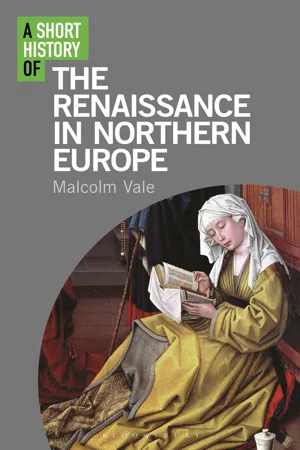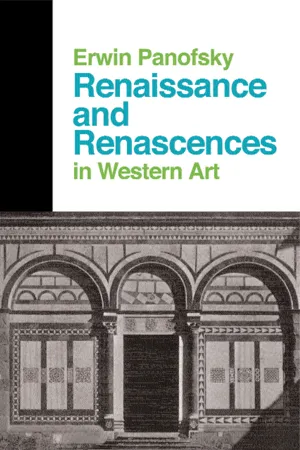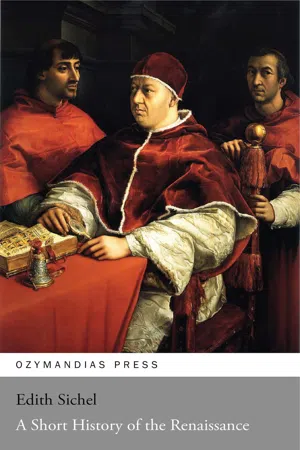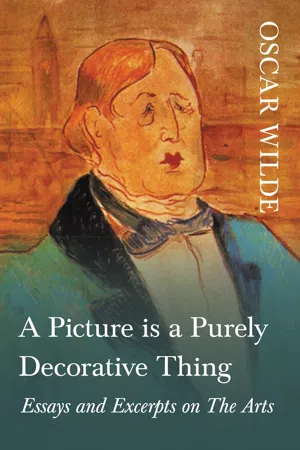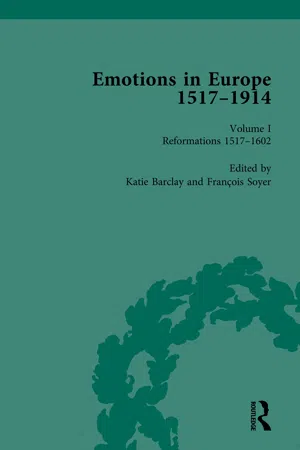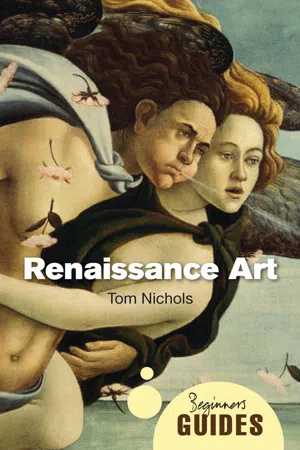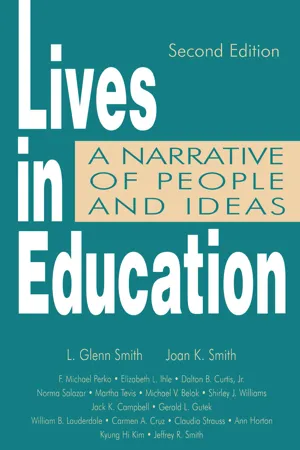History
Northern Renaissance
The Northern Renaissance was a cultural and artistic movement that took place in Northern Europe during the 15th and 16th centuries. It was characterized by a revival of interest in classical learning and a focus on individualism, realism, and naturalism in art. Key figures of the Northern Renaissance include Albrecht Dürer, Jan van Eyck, and Hans Holbein the Younger.
Written by Perlego with AI-assistance
Related key terms
10 Key excerpts on "Northern Renaissance"
- Malcolm Vale(Author)
- 2020(Publication Date)
- Bloomsbury Academic(Publisher)
The Art of the Renaissance in Northern Europe: Its Relations to the Contemporary Spiritual and Intellectual Movements. While seeing Northern Europe possessing certain distinctive traits which marked it off from Italian developments, Benesch in effect addressed only the sixteenth century in his account. Van Eyck, Van der Weyden, Memling, Bouts, Geertgen tot Sint Jans, Bosch and the other fifteenth-century Flemish and Dutch masters were excluded from his analysis. Artists from Durer (1471–1528) to Bruegel (1525–69), and the reception of Italianate styles in the North after 1500, rather than any indigenous Northern Renaissance before that date, provided his body of evidence. For all the notice taken of them, Courajod and Fierens-Gevaert might well never have existed. The definition of a Renaissance was crucial in determining whether or not it was confined to Italy. Yet the exclusively Italy-centred, Burckhardtian view of the Renaissance had other critics at this time. Their voices were certainly heard, but they gained comparatively little ground in the debate.One of those who became sceptical of Burckhardt’s interpretation was Abraham Moritz Warburg, known as Aby (1866–1929), from the Hamburg banking family of that name. He had renounced his partnership in the finance house of Warburg and become an independent scholar, furnished (largely at the firm’s expense) with a vast research library which formed the basis for the Warburg Institute. His background is not entirely unimportant as an influence on the directions taken by his work. Warburg thought that he could see some similarities between the banker dynasties of fifteenth-century Florence – the Medici, the Tornabuoni and the Sassetti – and the Hanseatic merchant-bankers of his own time. In one revealing comment on Domenico Ghirlandajo’s frescos commissioned by the Tornabuoni family in the church of Santa Maria Novella (1485–90), he remarked, somewhat tartly: ‘This is the kind of art a Renaissance banker’s family likes, because they get a much better deal than do either religion or art.’21Warburg also became profoundly dissatisfied with the conventional view of the Renaissance which had dominated his student days and which he had in part absorbed. He intensely disliked the late nineteenth-century aesthetic cult of the Renaissance, which saw the Florentine Quattrocento- eBook - ePub
- Erwin Panofsky(Author)
- 2018(Publication Date)
- Routledge(Publisher)
2 Suffice it to acknowledge the fact, established by many decades of serious and fruitful research, that the Renaissance was linked to the Middle Ages by a thousand ties; that the heritage of classical antiquity, even though the threads of tradition had become very thin at times, had never been lost beyond recuperation; and that there had been vigorous minor revivals before the "great revival" culminating in the Medicean age. It has been questioned whether the role of Italy in this "great revival" was really as important as claimed by the Italians themselves, and the contribution of the North has been stressed and analyzed not only with respect to sculpture and painting but also with respect to music and poetry. It has been debated whether the Renaissance includes or excludes the fourteenth century in Italy and the fifteenth in the Northern countries; and whether the seventeenth should be interpreted as its continuation or rather (as I am inclined to believe) as the beginning of a new, fourth era of history.Of late, however, the discussion has taken a new turn. There is a growing tendency, not so much to revise as to eliminate the concept of the Renaissance—to contest not only its uniqueness but its very existence. "Whatever qualifications a larger survey might compel one to make", we read in the context of an excellent argument vitiated only by the silent assumption that "mediaeval" and "Christian" are necessarily the same—"they would not alter the main conclusion that the classical humanism of the Renaissance was fundamentally medieval and fundamentally Christian".1 "This period [the Renaissance] is only the most famous and brilliant example of a cultural rebirth which coincides with and runs parallel to a revival of classical culture; but today it no longer needs to be proved that there has been a permanent tendency of revival throughout the last millennia of Western civilization".2 "This much we must grant—the great Renaissance was not so unique or so decisive as has been supposed; the contrast of culture was not necessarily so sharp as it seemed to the humanists and their modern followers, while within the Middle Ages there were intellectual revivals ... which partook of the same character as the better-known movement of the fifteenth century".3 And, finally: "There is no dividing line between 'medieval' and 'Renaissance' culture".4 - eBook - ePub
- Edith Sichel(Author)
- 2018(Publication Date)
- Ozymandias Press(Publisher)
THE RENAISSANCE OF THE NORTHERN RACES
OUT OF THE ITALIAN RENAISSANCE there issued a new-born art; out of the Northern Renaissance there came forth a new-born religion. There came forth also a great school of poetry, and a drama the greatest that the world had seen since the days of Greece. The religion was the offspring of Germany, the drama and the poetry that of England.There was thus, one might almost say, a gulf fixed between the Renaissance of the Northern peoples and that of the Latins in Italy whence the North drew its sustenance; and in the end Germany arose and with the sword of the Reformation slew the Mother-Renaissance. This is significant. Wherever the Renaissance broke with religion it ceased to live on as a direct movement. And in Italy, France and Spain, where modern Paganism, the Inquisition, the wars of Religion alike helped to corrupt and to arrest it, the Renaissance itself was exterminated even while it continued to work. But in the Teuton countries, in England and Germany, which in those days comprised the Netherlands and much of Switzerland, the Renaissance was carried straight forward, through the channels of religion on the one hand and of a great romantic drama on the other. Luther, no less than Shakespeare, was the child of the new ideas, of the cult of Nature and of Unity. And even when the later followers of the Reformation, the English Puritans, arose and made war against beauty, their cause was merged in political issues, and English freedom was too strong for it. The ultimate expression of puritanism was Milton, who was equally the child of the Renaissance.The Revival of Learning in Germany is sufficiently distinguished from that of Italy when we realize that among its principal sources was Thomas à Kempis (1380-1471). There gathered round that great mystic a group of devout scholars, apostles alike of knowledge and of Christianity, and one of them, Rudolph Agricola, earliest of Teutonic Humanists, was the first man of erudition to recognize the schoolboy Erasmus. Erasmus, the sovereign of the Northern Renaissance, was thus, as it were, the grandchild of Thomas à Kempis. Nor did these pioneers spring out of nothing. The German gift for the science of education is of long date, and, in the fourteenth century, the Schools of the Christian Brethren founded a tradition of wide culture as well as of piety. The contemporary Petrarch was not without effect upon this search after learning, but he did not initiate it. And Æneas Sylvius, when he came to Germany, brought with him the influence of Italy with lasting results; but he, also, only gave new life and new colour to what was there, witnessing further that the German Renaissance did not derive from Italy. - eBook - ePub
A History of Europe
From 1378 to 1494
- W.T. Waugh(Author)
- 2016(Publication Date)
- Routledge(Publisher)
CHAPTER XXITHE CLASSICAL RENAISSANCE, AND ITS RELATION TO THOUGHT, LETTERS, AND ART IN THE FIFTEENTH CENTURY
Traditional view of “the Renaissance”I T has been customary for historians to speak of “the Renaissance” as one of the great landmarks in the career of mankind. And, in view of the accredited conception of human history, the estimate was justified. For History fell into three clear-cut divisions. There was Ancient History, concerned with the fortunes of Greece from Homer to Alexander the Great and of Rome from Romulus to Marcus Aurelius or thereabouts, and thus dealing with communities which attained great material well-being, technical dexterity, intellectual power, and artistic taste. Then, with the decline of Rome, History entered its second phase—the Middle or Dark Ages, which lasted upwards of a thousand years. The regions comprised in the western half of the Roman Empire were submerged in barbarism. It was, in the words of a modern oracle, “a glacial age of the spirit.” Its literature was dismissed as “monkish,” its art as “Gothic,” its thought, we were told, culminated in the man whose name gave us the word “dunce.” Even after the Romantic Movement of the early nineteenth century had revived a sympathetic interest in the Middle Ages, they were admired because they were romantic, picturesque, or quaint. It was characteristic that medieval architecture was for long most highly appreciated when it was ruined. Even the great scholars who wrote on medieval history in the latter half of the nineteenth century, though they attributed many merits to medieval culture, usually assumed the existence of a great gulf between the Middle Ages and what were called Modern Times—the third Age of History.There was a general agreement that what at length lightened the darkness of error and superstition in which Europe had been wandering was the Renaissance, the rebirth of learning and art, moribund if not dead since the barbarians had overwhelmed Rome. Ancient literature, especially that of Greece, was revealed to minds weary of the tyranny of monks and schoolmen. The result was miraculous. “Men opened their eyes and saw.” And, looking at the world freely and directly, not through stained-glass windows, they saw that it was good. Scrutinizing the features and forms of their fellows, they found them worthy of admiration as creatures of flesh and blood, and not merely edifying as immortal souls destined probably for damnation. Their minds and imaginations emancipated, they turned from the trivialities of scholastic disputation to the great problems of life. Traditions, legends, superstitions crashed headlong. Beauty once more awoke. Literature recovered her form and comeliness. Grace and dignity unseen since the age of Pericles sprang into being under paint-brush and chisel. Man strode forth with head erect, ready not merely to endure but to master his fate. It was an inexhaustible theme, and much fine writing was provoked by it. - eBook - ePub
The Ascent of the West
From Prehistory Through the Renaissance
- Britannica Educational Publishing, Heather Campbell(Authors)
- 2010(Publication Date)
- Britannica Educational Publishing(Publisher)
Cities were also markets for culture. The resumption of urban growth in the second half of the 15th century coincided with the diffusion of Renaissance ideas and educational values. Humanism offered linguistic and rhetorical skills that were becoming indispensable for nobles and commoners seeking careers in diplomacy and government administration, while the Renaissance ideal of the perfect gentleman was a cultural style that had great appeal in this age of growing courtly refinement. At first many who wanted a humanist education went to Italy, and many foreign names appear on the rosters of the Italian universities. By the end of the century, however, such northern cities as London, Paris, Antwerp, and Augsburg were becoming centres of humanist activity rivaling Italy’s. The development of printing, by making books cheaper and more plentiful, also quickened the diffusion of humanism.A textbook convention, heavily armoured against truth by constant reiteration, states that northern humanism—i.e., humanism outside Italy—was essentially Christian in spirit and purpose, in contrast to the essentially secular nature of Italian humanism. In fact, however, the program of Christian humanism had been laid out by Italian humanists of the stamp of Lorenzo Valla, one of the founders of Classical philology, who showed how the critical methods used to study the Classics ought to be applied to problems of biblical exegesis and translation as well as church history. That this program only began to be carried out in the 16th century, particularly in the countries of northern Europe (and Spain), is a matter of chronology rather than of geography. In the 15th century, the necessary skills, particularly the knowledge of Greek, were possessed by a few scholars. A century later, Greek was a regular part of the humanist curriculum, and Hebrew was becoming much better known, particularly after Johannes Reuchlin published his Hebrew grammar in 1506. Here, too, printing was a crucial factor, for it made available a host of lexicographical and grammatical handbooks and allowed the establishment of normative biblical texts and the comparison of different versions of the Bible. - eBook - ePub
Please Don't Wish Me a Merry Christmas
A Critical History of the Separation of Church and State
- Stephen M Feldman(Author)
- 1998(Publication Date)
- NYU Press(Publisher)
HAPTER 4The Christian Renaissance and Reformation in Continental EuropeTHE RENAISSANCE
Toward the end of the Middle Ages, certain Italian cities such as Venice and Florence, spurred by fortuitous economic prosperity, strove for independence from the Holy Roman Empire.1 Already, in the mid-fourteenth century, Bartolus argued that the free people of the cities (or city republics) were exercising de facto merum Imperium (the highest power to make laws), so they effectively constituted sibi princeps (a prince unto themselves). During this era, though, the cities had to remain wary of papal domination, and thus many writers, such as Dante, still sided with the emperor to avoid the pope. Other writers nonetheless insisted that the Church should not interfere in the secular affairs of the cities. As early as 1324, Marsiglio of Padua anticipated a central Reformation theme when he argued that the city republics had secular jurisdiction separate from the Church. While the fate of these city republics fluctuated over the years, they provided fertile political soil for the growth of a modern theory of the state.2In particular, the civic humanism of the Renaissance bloomed during the fifteenth and sixteenth centuries. Just as Thomas Aquinas previously had turned to Aristotelian theory to develop the concept of the state, the early civic humanists turned to Cicero. The humanist emphasis on the Ciceronian concept of virtus—the single or highest virtue, uniting wisdom with eloquence—contrasted sharply with the Augustinian Christian view of human nature. Whereas Augustinians saw only human depravity and sin, the humanists believed people, as citizens, could achieve excellence in political and civil society. Nonetheless, the early humanists remained fervent Christians, struggling to force their ideas of virtus into a Christian framework, and the later Northern humanists even insisted that political rulers possess the godliness of a good Christian.3 - Oscar Wilde(Author)
- 2020(Publication Date)
- Read & Co. Great Essays(Publisher)
So, in the lecture which I have the honour to deliver before you, I will not try to give you any abstract definition of beauty—any such universal formula for it as was sought for by the philosophy of the eighteenth century—still less to communicate to you that which in its essence is incommunicable, the virtue by which a particular picture or poem affects us with a unique and special joy; but rather to point out to you the general ideas which characterise the great English Renaissance of Art in this century, to discover their source, as far as that is possible, and to estimate their future as far as that is possible. I call it our English Renaissance because it is indeed a sort of new birth of the spirit of man, like the great Italian Renaissance of the fifteenth century, in its desire for a more gracious and comely way of life, its passion for physical beauty, its exclusive attention to form, its seeking for new subjects for poetry, new forms of art, new intellectual and imaginative enjoyments: and I call it our romantic movement because it is our most recent expressio n of beauty. It has been described as a mere revival of Greek modes of thought, and again as a mere revival of mediæval feeling. Rather I would say that to these forms of the human spirit it has added whatever of artistic value the intricacy and complexity and experience of modern life can give: taking from the one its clearness of vision and its sustained calm, from the other its variety of expression and the mystery of its vision- eBook - ePub
Emotions in Europe, 1517-1914
Volume I: Reformations,1517-1602
- Katie Barclay, François Soyer, Katie Barclay, François Soyer(Authors)
- 2021(Publication Date)
- Routledge(Publisher)
Part 6ART AND CULTUREPart 6 Art and Culture
European art and culture of the sixteenth century was influenced by the spread of Renaissance culture and ideas from Italy to the rest of the continent. Visual artworks, both those with religious subjects and those with more profane themes, paid close attention to the depiction of human emotions that would, in turn, elicit emotional reactions from those who viewed the works. The impact of the Protestant Reformation and the printing press is also evident as artworks produced after 1517 often had an agenda linked to the religious strife dividing Europe. Art and propaganda frequently coalesced to create artworks explicitly seeking to inspire horror, fear, anger and hatred of the opposing side or, alternatively, using humour in order to provoke laughter and ridicule rival beliefs. Insofar as literature is concerned, the printing press and rise of a literate lay readership led to the printing of early novels and satirical works designed to appeal to the profane emotions of a lay reader.Passage contains an image
44ALBRECHT DÜRER (1471–1528), HEAD OF A WEEPING CHERUBAlbrecht Dürer is one of the most famous German painters, printmakers, and art theorists of the German Renaissance.1 This drawing in chalk, variously entitled Head of a Weeping Cherub or Head of a Weeping Angel was a study for an engraving entitled The Great Crucifixion - eBook - ePub
Renaissance Art
A Beginner's Guide
- Tom Nichols(Author)
- 2012(Publication Date)
- Oneworld Publications(Publisher)
The disturbing imagery of Hieronymus Bosch reflects this troubled cultural atmosphere: one that very soon led to the rebellion against the established church known as the Protestant Reformation. In 1517, Martin Luther nailed his 95 theses or complaints on the door of Wittenberg Cathedral and so initiated a rejection of Roman Catholicism that was destined to divide European Christianity as never before. What was the impact of this fundamental religious change on the further development of Renaissance art? The movement was not fundamentally driven by religious values; but neither was it opposed to them. As we have seen, the realistic artistic styles of the fifteenth and early sixteenth centuries often served to visualise traditional Christian principles in newly affective ways. But with the coming of the Reformation, this kind of easy alliance between art and religion was directly challenged.From the 1520s onwards, many Reformers questioned the established place of visual art in religious life, and artists were forced to take their careers in different directions. Leading figures in the north such as Lucas van Leyden (c. 1494–1533), Lucas Cranach (1472–1553), Hans Holbein (1497/8–1543), and Pieter Bruegel (c. 1525–69) none the less managed to carve out successful careers. Religious art did not simply end with the Reformation: artists such as Cranach invented new kinds of religious iconography (see box on this page ) that served the reformed religion. But both he and the others discussed in this chapter also developed ‘empirical’ kinds of art (such as portraiture, genre images , and landscape) that referred more directly to the present world. The Renaissance has often been seen as ‘secularising’ the religious Middle Ages. But this move had to wait for the Reformation before really taking root in north European art.A Renaissance eccentric?Hieronymus Bosch is often seen as one of the most eccentric figures of the Renaissance whose paintings have little to do with those of other artists of the period. His frequent use of bizarre half-human half-animal forms, of strange outsized objects both man-made and natural, and of weird fleshy shapes sculpted into fountain-like structures (see particularly the mysterious triptych known as the Garden of earthly delights - eBook - ePub
Lives in Education
A Narrative of People and Ideas
- Joan K. Smith, L. Glenn Smith, L. Glenn Smith(Authors)
- 2023(Publication Date)
- Routledge(Publisher)
The emphasis Machiavelli placed on experience also marks him as a modern person. Classical examples abound in his works, but his own experience was the most important source. His firsthand experience of the danger of indecisive rulers in Florence resulted in his glorification of decisive action. He used the classics and built on them rather than worshiping them. Because of that, he was a humanist—though hardly a humane one.Summary
The Renaissance is important because it refocused educational orientation, away from an exclusively religious purpose to greater emphasis on the human condition. Experience, enlightened by selected Greek and Roman authors such as Cicero, informed the concerns of Renaissance men and women. There was as much emphasis on the creation of new art and literature—which reflected classical style—as on studying the past.One of the most important dimensions of the “new learning” was the development of vernacular languages (such as English, Spanish, German, Italian, and French) and of extensive literatures in them. This meant that formal schooling became again, as it had been under the Romans, bilingual or multilingual. Every educated European learned Latin (and possibly Greek and Hebrew) and his or her own tongue. Greek labels, such as gymnasium, academy, and lyceum, came to be applied to centers of classical study.The Renaissance is also important because it spawned the women's movement in education. It was not because humanists like Erasmus advocated restricted education of women that we identify a new impetus for women's education. Rather, it was the courageous and literate challenge of Christine de Pisan for gender equality in education and life that marked the Renaissance as a time of change in the history of education for women.Finally, it is important to remember that the humanities included study of all aspects of human beings: beautiful and ugly, triumphant and pathetic, generous and mean. Although humanists like Vittorino da Feltre embodied humane gentleness, the hard-headed realism of Niccolò Machiavelli was also part of the humanist tradition. The Reformation would keep the classical and vernacular thrusts of the Renaissance while reclaiming the earlier religious purpose of education.
Index pages curate the most relevant extracts from our library of academic textbooks. They’ve been created using an in-house natural language model (NLM), each adding context and meaning to key research topics.
